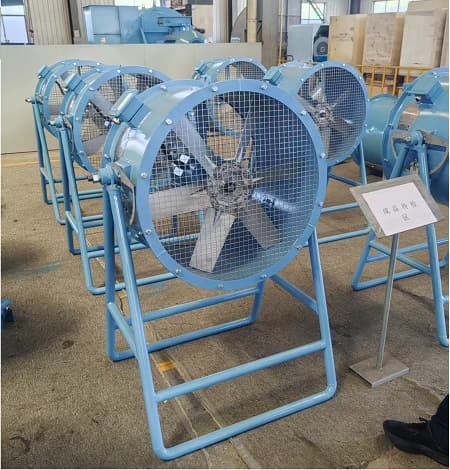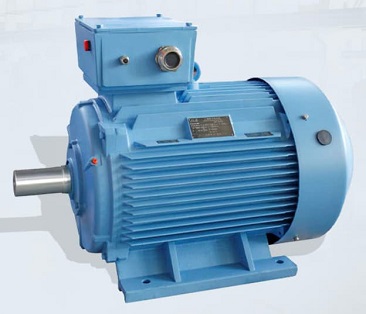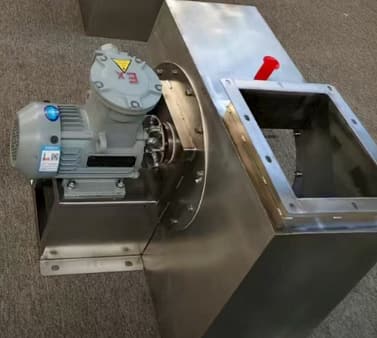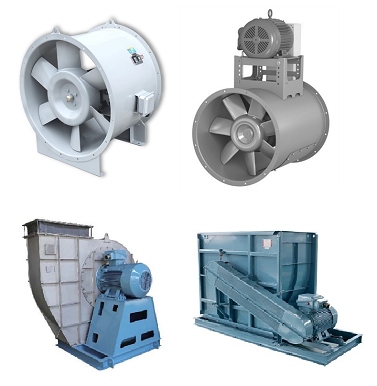Brief Intro of Axial Fan
Axial fans play a vital role in ventilation, cooling, and HVAC applications across various industries. As a leading manufacturer of industrial ventilation solutions in China, Zhejiang Shuangyang Fans Holding Co., Ltd provides high-efficiency axial fans engineered for metro tunnel systems, factories, commercial buildings, and more. Understanding of the structure of axial fan is essential to assess its performance, durability, and adaptability for different applications.
Core Components of an Axial Fan
An axial fan moves air along the axis of the fan shaft. The key components of its structure include:
-
Fan Impeller (Blades + Hub)
-
Motor
-
Housing or Casing
-
Inlet Cone or Bellmouth
-
Mounting Frame or Support Bracket
-
Protective Grilles or Louvers
-
Optional: Sound Attenuators, Guide Vanes
Each component is engineered for optimal aerodynamic performance, reliability, and noise control. The integration and arrangement of these parts determine the fan’s airflow capacity and pressure generation.
Fan Impeller: Blade and Hub Design
The impeller is the heart of the axial fan, composed of blades connected to a central hub. The blade profile, material, and pitch angle significantly affect airflow performance.
Blade Types:
Flat, airfoil, and sickle-shaped blades are commonly used. Airfoil blades offer high efficiency and low noise.
Blade Pitch:
Fixed or adjustable pitch blades allow customization of airflow and static pressure. Adjustable pitch is ideal for large-scale applications like tunnel ventilation or high-rise building exhaust.
Materials:
Carbon steel, aluminum, stainless steel, or reinforced plastic are selected based on corrosion resistance, strength, and weight.
Connection:
Blades are attached to the hub using riveting, welding, or bolted connections. In heavy-duty models, bolted adjustable-pitch blades are preferred for maintenance flexibility.
Motor and Drive Mechanism
Axial fans can be direct-drive or belt-drive:
Direct-drive axial fans have the motor directly connected to the impeller shaft. This ensures compact structure, low maintenance, and high efficiency, commonly used in HVAC and industrial applications.
Belt-drive designs allow speed variation and reduce vibration transmission, but they require more maintenance.
For high-performance applications, EC motors (Electronically Commutated) and variable frequency drives (VFD) are used to enhance energy efficiency and control.
Fan Housing and Casing
The fan casing not only protects internal components but also influences airflow pattern and noise levels. It can be:
Typical for duct-mounted or inline axial fans.
Square or Rectangular with Flanges:
Common for wall-mounted exhaust fans or unitary ventilation systems.
Found in cabinet axial fans, which reduce operational noise using internal lining materials.
Premium casings include anti-corrosion coatings and vibration-damping structures, essential in coastal, chemical, or underground environments.
Installation Options
Axial fans are versatile in installation:
-
Ceiling-mounted
Roof-mounted
-
Duct-connected inline axial fans
-
Free-standing for large-scale industrial use
Structural supports include mounting feet, anti-vibration pads, and shock mounts.
Accessories and Enhancements
Installed downstream to straighten airflow and improve efficiency.
Diffusers and Inlet Cones:
Improve air intake and reduce turbulence.
Sound Attenuators:
Duct-type or integrated silencers are used in tunnel ventilation or noise-sensitive applications.
Protective Grilles:
Ensure safety for personnel and prevent debris ingress.
These structural enhancements help axial fans meet specific noise, safety, or aerodynamic standards required by local codes.
Conclusion
The structure of an axial fan is more than a sum of its parts—it’s a carefully engineered system designed for aerodynamic efficiency, mechanical strength, and adaptability to diverse environments. Whether it’s a tunnel, metro project, industrial workshop, or HVAC system, selecting the right structure is key to achieving optimal ventilation performance and energy savings.
At SHUANGYANG FAN, we provide axial fans with customizable structures to meet the demanding technical requirements. With advanced production and testing capabilities, we deliver quality you can rely on.
Note: The content of the article cannot avoid omissions and errors. Welcome to propose corrections.
 Mancooler (Workstation) Fans — Why Your Factory Needs the Right One
Mancooler (Workstation) Fans — Why Your Factory Needs the Right One
 Motor Classifications in Industrial Fans
Motor Classifications in Industrial Fans
 Materials for Explosion-Proof Fan
Materials for Explosion-Proof Fan
 Direct Drive vs. Belt Drive in Axial Fan and Centrifugal Fan
Direct Drive vs. Belt Drive in Axial Fan and Centrifugal Fan

